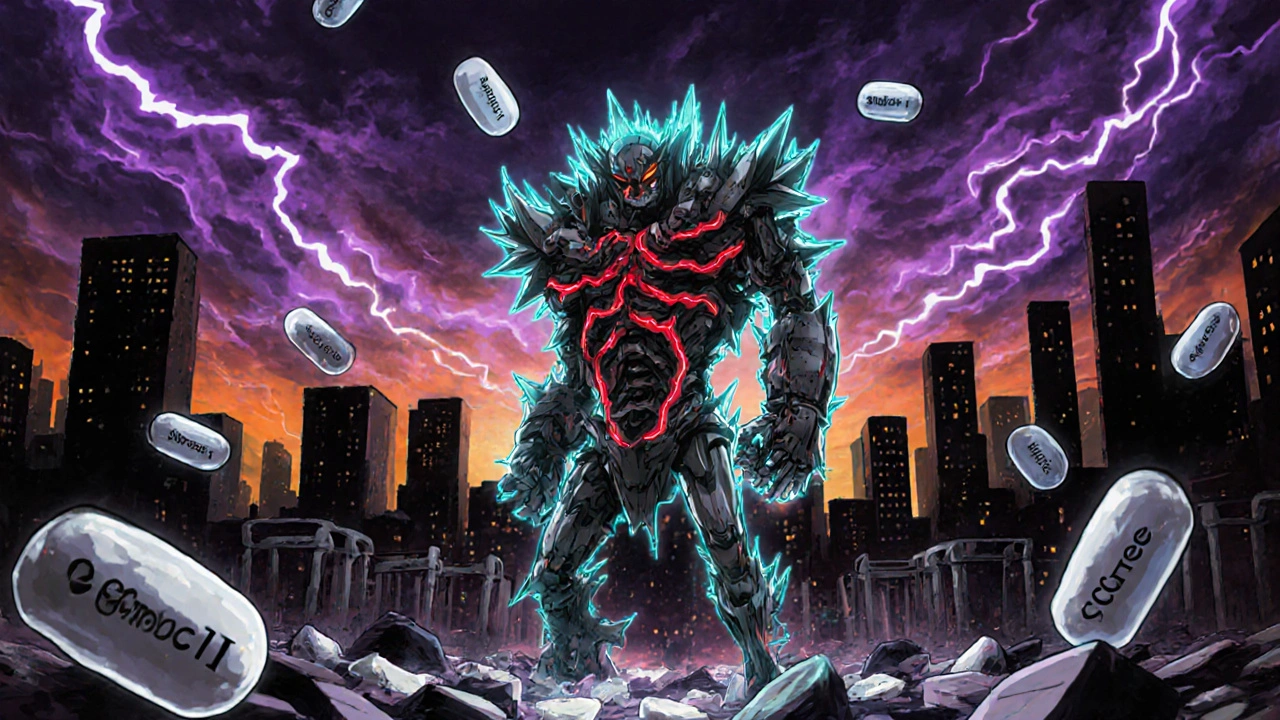MRSA isn’t just another infection. It’s a bacteria that laughs at antibiotics most people rely on. If you’ve ever had a boil that wouldn’t heal, or a wound that turned red and angry despite cleaning it, you might be looking at MRSA. And the scary part? It’s not just showing up in hospitals anymore. It’s in gyms, locker rooms, prisons, and even your kid’s soccer team. The line between what’s called community MRSA and hospital MRSA is fading fast-and that changes everything about how you treat it, prevent it, and understand where it came from.
What Exactly Is MRSA?
MRSA stands for methicillin-resistant Staphylococcus aureus. That’s a mouthful, but here’s the simple version: it’s a type of staph bacteria that doesn’t respond to common antibiotics like methicillin, penicillin, or amoxicillin. Staph bacteria live on skin and in noses of about 1 in 3 people without causing harm. But when it gets into a cut, scrape, or surgical wound, it can turn dangerous. And MRSA? It’s the version that fights back.
It first appeared in hospitals in the 1960s after methicillin was introduced. Doctors used it to treat staph infections, and the bacteria adapted. But in the late 1990s, something unexpected happened. Healthy people-no hospital visits, no catheters, no recent surgery-started getting serious MRSA infections. These were called community-associated MRSA, or CA-MRSA. Now, decades later, the two types aren’t just overlapping. They’re mixing.
CA-MRSA vs. HA-MRSA: The Genetic Difference
Not all MRSA is the same. Genetically, they’re built differently.
Community MRSA (CA-MRSA) usually carries a small piece of DNA called SCCmec type IV or V. This makes it less resistant to antibiotics overall-but it packs a stronger punch in terms of damage. These strains often produce a toxin called Panton-Valentine leukocidin (PVL). That toxin kills white blood cells, which is why CA-MRSA causes nasty skin abscesses, boils, and sometimes life-threatening pneumonia in otherwise healthy people.
The most common strain in the U.S. is USA300. It accounts for about 70% of community cases. It spreads easily through skin contact, shared towels, or dirty gym equipment. It’s the kind of MRSA you get from wrestling, sharing a razor, or touching a contaminated bench in a public shower.
Hospital MRSA (HA-MRSA) carries bigger DNA packages-SCCmec types I, II, or III. These let the bacteria resist not just penicillin, but also clindamycin, erythromycin, and fluoroquinolones. That’s why HA-MRSA patients often need stronger, more toxic drugs. These strains thrive in hospitals because they’ve adapted to survive the heavy antibiotic use there. They’re more likely to cause bloodstream infections, pneumonia after surgery, or infections around catheters and IV lines.
Here’s the kicker: CA-MRSA strains are now showing up in hospitals. And HA-MRSA strains are popping up in the community. A Canadian study found that nearly 28% of hospital MRSA cases came from community strains. That means the old rules don’t work anymore.
How It Spreads: Where You’re at Risk
CA-MRSA spreads through direct skin-to-skin contact. Think:
- Sharing towels or razors
- Touching surfaces in gyms, saunas, or locker rooms
- Playing contact sports like wrestling or football
- Living in crowded places-prisons, homeless shelters, military barracks
Studies show the risk is 14.9 times higher in prisons and 12.3 times higher in military barracks. Why? Close quarters, shared equipment, and sometimes poor hygiene. Injecting drug users are also a major reservoir-skin punctures, reused needles, and dirty environments make transmission easy. USA300 is especially common in this group.
HA-MRSA spreads differently. It’s carried by healthcare workers who don’t wash hands properly, or through contaminated equipment. A patient with MRSA in their nose can pass it to someone else during a procedure. Even short hospital stays-just 4 or 5 days-are long enough for transmission if hygiene slips.
The problem? People leave the hospital with MRSA on their skin and bring it home. Then, their family members get infected. Or a healthy person with CA-MRSA gets hospitalized for a broken leg-and suddenly, they’re spreading hospital-resistant strains.

Symptoms: How to Spot the Difference
Both types often start the same way: a red, swollen, painful bump that looks like a spider bite or pimple. It may drain pus. Fever and warmth around the area are common.
But here’s where they diverge:
- CA-MRSA: Usually limited to skin and soft tissue. Most people recover quickly with drainage and basic care. Hospital stays average just 1.5 to 2.8 days.
- HA-MRSA: Often invades deeper. Bloodstream infections, pneumonia, surgical site infections. Hospital stays last weeks-sometimes over 20 days.
If you have a skin infection and you’ve been in the hospital, had dialysis, or have a catheter in the past year, it’s more likely HA-MRSA. But if you’re healthy, young, and got the infection after working out or being in a crowded dorm? It’s probably CA-MRSA. Except now, you can’t always tell.
Treatment: What Works and What Doesn’t
Antibiotics are not always the answer-and never the first step for skin infections.
For most CA-MRSA skin abscesses, the best treatment is simple: drain the pus. Doctors make a small cut, let it out, clean it, and bandage it. Antibiotics? Often unnecessary. If needed, the go-to options are:
- Clindamycin (96% effective against CA-MRSA)
- Trimethoprim-sulfamethoxazole (Bactrim)
- Tetracycline or doxycycline
HA-MRSA? It’s a different story. Because it’s resistant to so many drugs, you need stronger options:
- Vancomycin
- Daptomycin
- Linezolid
- Teicoplanin
But here’s the twist: CA-MRSA strains are now carrying HA-MRSA resistance genes. Some strains are hybrids-virulent like CA-MRSA but resistant like HA-MRSA. That means doctors can’t assume anymore. A skin infection in a 25-year-old athlete might need vancomycin if it’s one of these new hybrids.
That’s why labs now do genetic testing on MRSA samples. Not just to confirm it’s MRSA, but to figure out what kind it is. Treatment is changing from “one-size-fits-all” to “strain-specific.”

The Blurring Line: Why Old Definitions Don’t Work
The CDC used to define CA-MRSA as infections in people with no recent hospital contact. That made sense in 2000. Now? It’s outdated.
A person might have had a minor surgery two years ago. Or visited a relative in a nursing home. Or gotten a flu shot at a clinic. That’s not “hospital exposure” by old definitions-but it’s enough to pick up HA-MRSA. Meanwhile, someone with no hospital history might have picked up a CA-MRSA strain from a friend who works in a hospital.
Studies show that a patient’s medical history is a terrible predictor of what strain they have. The bacteria don’t care about your paperwork. They care about opportunity.
This is why experts now say: stop thinking of MRSA as two separate problems. Think of it as one big, moving ecosystem. Hospitals are not isolated. Communities aren’t safe havens. MRSA moves between them constantly-on clothes, hands, and skin.
What You Can Do: Prevention That Actually Works
Handwashing is still the #1 defense. But it’s not enough.
- Keep cuts clean and covered until healed.
- Don’t share personal items: towels, razors, athletic gear.
- Shower immediately after sports or gym sessions.
- Use a barrier (like a towel) on shared gym equipment.
- If you’re in a high-risk setting-prison, shelter, military-ask about screening and decolonization protocols.
- If you’re hospitalized, remind staff to wash hands before touching you.
Decolonization (using nasal ointments and special body washes) helps in hospitals, but it’s not routine for healthy people. Why? Because it’s not always effective long-term, and overuse can lead to resistance.
Bottom line: treat every MRSA infection like it could be the next big outbreak. Don’t ignore a bump. Don’t wait for it to get worse. Get it checked.
The Future: Integrated Surveillance Is the Only Way Forward
Trying to control MRSA by treating hospitals and communities as separate worlds is like trying to stop a flood by plugging one hole while ignoring the river upstream.
Researchers are calling for unified surveillance systems that track MRSA across all settings. Hospitals need to test not just patients who’ve been hospitalized, but everyone. Communities need better access to rapid testing. Public health agencies need to share data in real time.
Without this, we’re stuck in a cycle: CA-MRSA enters hospitals, evolves into hybrid strains, spreads back to the community, and the cycle repeats. The longer we wait, the harder it becomes to treat.
MRSA isn’t going away. But we can stop letting it win-by understanding how it moves, who it affects, and what really works to stop it.
